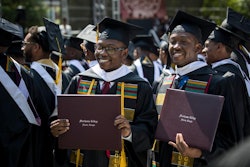A Nation Still at Risk, Panel Says
Two decades after publication of landmark education study, scholars find little progress
By Ben HammerWASHINGTON
In late April, the U.S. Department of Education brought a handful of leading scholars together to mark the anniversary of the 1983 report “A Nation at Risk” that brought the country’s attention to a broken education system. Panel members agreed that little progress has been made in improving academic achievement in the 20 years since the report.
The National Commission on Excellence in Education in 1983 said the country’s educational institutions had lost sight of the basic purposes of schooling and of the high expectations and disciplined effort necessary to attain them. In its report, the commission expressed concern that the quality of the “intellectual, moral and spiritual strengths of our people” was endangered.
Panel members at the Education Department event were contributors to “A Nation Reformed” — a review of education reform since the 1983 report, or were members of the Hoover Institution’s Koret Task Force on K-12 Education. Though billed as a discussion of rival viewpoints, panel members agreed on many things about the state of education today.
“What ‘A Nation at Risk’ really did was … got the nation thinking about education as an issue of national priority, national security, and it really put education as a top priority,” says David T. Gordon, editor of the Harvard Education Letter. “We’ve been having a national conversation for 20 years now about what we want schools to do.”
The report helped change public perception about the role and importance of education, says Dr. Patricia A. Graham, the Charles Warren Research Professor of the History of American Education at Harvard University’s Graduate School of Education.
“Until about 20 years ago, we believed that it was OK if some American youth achieved academically. So one of the biggest changes is that we think that every American youth should achieve academically,” Graham says. “To get a change in public attitude is a powerful thing to get because most school systems respond to what the public thinks they need to do.”
The change in public attitude has led to greater commitment of resources to schools over the last two decades for several reasons, says Dr. Caroline Hoxby, a Harvard University professor of economics and a visiting professor at Yale this year.
Studies like “A Nation at Risk” made governors and legislators aware of low achievement levels in the schools. Also, since 1983 the U.S. economy has become much more skills-based, making it more important that everyone get a good education. Finally, legislators have gone out of their way to spend on education and want to see some return in improved achievement levels.
“If you really want to look at what is different now, people in 1983 knew that achievement was really bad, but were not frustrated about it,” Hoxby says. “If you look at the same people today, they are very frustrated.”
Other panel members agreed that the country is more focused on educational reform and said that the increase in consciousness on the issue may lead to more bold initiatives.
“One of the most important things is that we’re more bent on reform in a serious way than we ever have been before,” says Dr. Chester E. Finn Jr., a senior fellow at the Hoover Institution and president of the Thomas B. Fordham Foundation. “We’re probably a little more willing to break a little china and do some things we weren’t willing to do 20 years ago.”
Many of the participants say attracting and retaining higher quality teachers is an important goal that can be achieved, in part, by making teaching more of a profession and increasing continuing education efforts.
“Teaching no longer looks attractive to highly qualified adults,” Gordon says. “If they do it now, we expect them to do it because they are saints — to stick it out for the love of it, and I don’t think that’s reasonable.”
Panel members have a host of recommendations for how to improve achievement levels in America’s schools — some of which mirror those in the original 1983 report.
Graham recommends putting all children through high-quality pre-school programs and limiting teenagers’ work hours during the school year.
Robert B. Schwartz, a lecturer at Harvard University’s Graduate School of Education, says schools need to build more capacity to achieve more on standards assessments, and that a serious effort needs to be made to make teaching more of a profession. Also, he says he’s concerned about the gap that remains between the best and worst schools and that it is undermining the “social cohesion of our society.”
For Hoxby, who researches the labor economics of education, increasing salaries alone will never improve teaching quality, in part because doing so leads bad teachers to stay in the system longer. However, tying teachers’ salaries to performance — as measured by data on their students’ performance in school — could be an effective way to improve teaching quality.
“Practically speaking, it’s not hard to do, aside from the politics,” Hoxby says. “I think we really ought to get over the politics for the sake of the kids.”
© Copyright 2005 by DiverseEducation.com


















